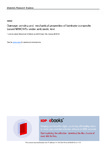Damage sensing and mechanical properties of laminate composite based MWCNTs under anticlastic test

Date
2018-12-19Author
Subject
Metadata
Show full item recordAbstract
Self-sensing composite based MWCNTs is important to diagnose the damage in its early stage and to prevent a fatal fracture that could happen in the structure during the working. This paper investigates the effect of adding different concentrations of MWCNTs to the matrix on the mechanical and electro-mechanical properties of the composite laminates under a different type of testing. MWCNTs were a dispersion in the epoxy resin using ultrasonic technique and then the mixture handed lay-up on the glass fibre composite layers followed by vacuum bagging process. The composite samples, which have various percentages of MWCNTs, have been tested using flexural and anticlastic tests. This type of complex test i.e. (anticlastic) gives more understanding to explore the effect of combined twisting and bending deformation on the strain sensitivity of the glass fibre /MWCNTs reinforced composite. The results indicated that the adding of MWCNTs can improve the mechanical properties of the smart composite. The maximum stresses values were observed at the flexural test while the maximum Young's modulus values were at the anticlastic test. SEM pictures have captured from the broken surface to exam the MWCNTs dispersion inside the resin and between the glass fibre layers. From the SEM images, MWCNTs were distributed well inside the matrix while there are some agglomerations occurs at the 2.0 wt% of MWCNTs. The electrical conductivity increases with increasing the wt% of MWCNTs content and showing a high value 1.8 × 10-3 s m-1 at 2.0 wt% of MWCNTs content. The strain deformation due to the flexural test was one i.e. in (y-direction) only and was higher than both strain values when the sample under the anticlastic test. The results also show that there are two strain sensitivities but in opposite signs which obtained by anticlastic test while one only under flexural test and had a magnitude equal to about half value compare with those for the anticlastic test. Therefore, this type of test gives a deep vision to investigate the behaviour of the smart composite when it deforms to a saddle shape.
Collections
Publisher
Journal
Volume
Issue
Pagination
Number
Recommended, similar items
The following license files are associated with this item:

